EXCURSIONS IN AND AROUND MACERATA AND IT’S PROVINCE
 MACERATA is the capital of the province highly interesting from a historic and artistic point of view, rich in renaissance and baroque monuments. The Basilica della Misericordia was built on a drawing of Vanvitelli during the first half of the XVIII century; the Duomo; Piazza della Libertà with the Loggia dei Mercanti and the Teatro Lauro Rossi, built in 1767 from a drawing of Antonio Bibiena; the Museo della Carrozza with its rich collection of coaches and the Pinacoteca with its collection of Umbro- marchigiani artists from the XIV to the XIX century amongst which a Madonna con bambino by Carlo Crivelli. Not to be missed a visit to the Arena Sferisterio, symbol and pride of the city, an imposing neoclassical building built for the palla al bracciale game (ball and bracelet), today venue of the Macerata Opera Festival. Link: http://www.sferisterio.it/prehome/index.php
MACERATA is the capital of the province highly interesting from a historic and artistic point of view, rich in renaissance and baroque monuments. The Basilica della Misericordia was built on a drawing of Vanvitelli during the first half of the XVIII century; the Duomo; Piazza della Libertà with the Loggia dei Mercanti and the Teatro Lauro Rossi, built in 1767 from a drawing of Antonio Bibiena; the Museo della Carrozza with its rich collection of coaches and the Pinacoteca with its collection of Umbro- marchigiani artists from the XIV to the XIX century amongst which a Madonna con bambino by Carlo Crivelli. Not to be missed a visit to the Arena Sferisterio, symbol and pride of the city, an imposing neoclassical building built for the palla al bracciale game (ball and bracelet), today venue of the Macerata Opera Festival. Link: http://www.sferisterio.it/prehome/index.php
 RECANATI Owes its international notoriousness to Giacomo Leopardi the romantic poet that drew inspiration from this town and its surrounding landscape for his immortal poetry. To be seen the little square Piazzetta del “Sabato del Villaggio” , Casa Leopardi, where all the original manuscripts and objects belonging to the poet are kept, the Church of St. Agostino and the Tower Torre del passero Solitario, the Colle dell’Infinito; the Pinacoteca Civica has a rich collection of art , amongst which the magnificent Annunciazione by Lorenzo Lotto. The Museo Civico keeps many memories, relics and stage costumes belonging to the famous tenor Beniamino Gigli, another celebrity from Recanati. Link: http://www.recanatiturismo.it/
RECANATI Owes its international notoriousness to Giacomo Leopardi the romantic poet that drew inspiration from this town and its surrounding landscape for his immortal poetry. To be seen the little square Piazzetta del “Sabato del Villaggio” , Casa Leopardi, where all the original manuscripts and objects belonging to the poet are kept, the Church of St. Agostino and the Tower Torre del passero Solitario, the Colle dell’Infinito; the Pinacoteca Civica has a rich collection of art , amongst which the magnificent Annunciazione by Lorenzo Lotto. The Museo Civico keeps many memories, relics and stage costumes belonging to the famous tenor Beniamino Gigli, another celebrity from Recanati. Link: http://www.recanatiturismo.it/
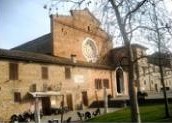 THE ABBEYS FROM THE PROVINCE. San Firmano Abbey (Montelupone) has a distinctive interior on three levels and dates back to the tenth century; Santa Maria a Piè di Chienti Abbey (Montecosaro Scalo) is a real jewel of Romanic art and one of the most prestigious monuments of the whole Marche region; San Claudio al Chienti (Corridonia), in ravenate Style, with two characteristic cylindrical towers at the sides of the main portal. Chiaravalle di Fiastra Abbey (Tolentino) is one of the better preserved cystercensian abbeys in Italy. Founded in 1142 by monks coming from Chiaravalle in Milano, is placed in the centre of the Riserva Naturale Abbadia di Fiastra. Besides the church to be seen are: the cloister, the refectory, the grotte, the cellarium and the sala delle oliere, where there is a photographic exhibition on all the Abbeys in the Marche. The visit continues at Rambona Abbey (Pollenza) founded in the VIII century by the longobard queen Ageltrude. Fascinating cript supported by roman columns. Link: http://www.macerataguideturistichemarche.com/abbazie.html
THE ABBEYS FROM THE PROVINCE. San Firmano Abbey (Montelupone) has a distinctive interior on three levels and dates back to the tenth century; Santa Maria a Piè di Chienti Abbey (Montecosaro Scalo) is a real jewel of Romanic art and one of the most prestigious monuments of the whole Marche region; San Claudio al Chienti (Corridonia), in ravenate Style, with two characteristic cylindrical towers at the sides of the main portal. Chiaravalle di Fiastra Abbey (Tolentino) is one of the better preserved cystercensian abbeys in Italy. Founded in 1142 by monks coming from Chiaravalle in Milano, is placed in the centre of the Riserva Naturale Abbadia di Fiastra. Besides the church to be seen are: the cloister, the refectory, the grotte, the cellarium and the sala delle oliere, where there is a photographic exhibition on all the Abbeys in the Marche. The visit continues at Rambona Abbey (Pollenza) founded in the VIII century by the longobard queen Ageltrude. Fascinating cript supported by roman columns. Link: http://www.macerataguideturistichemarche.com/abbazie.html
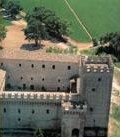 FORTRESSES AND CASTLES. To be visited Tolentino, city of San Nicola, performer of miracles that lived at the end of the XIIIth century. The visit starts at the Basilica of San Nicola where there is a fantastic cycle of frescoes of the trecento Rimini school. In the basilica there are also the Museo della Ceramica, Museo of the Opera and the Museo of the ex-voto. Particularily interesting is the annexed cloister of the thirteenth century. The tour continues in Piazza Della Libertà where the famous Torre degli Orologi tower is to be seen for its dials that tell the hour, the day, and moon phases. At the Palazzo Sangallo you can visit the Museo della Caricatura e dell’Umorismo nell’Arte, a unique museum recently renewed. Not to be missed is the Castello della Rancia at a few Kilometers from the town. The original building was a fortified farmhouse owned by the monks of the Chiaravelle di Fiastra Abbey, it was transformed in to a castle in the XIVth century.
FORTRESSES AND CASTLES. To be visited Tolentino, city of San Nicola, performer of miracles that lived at the end of the XIIIth century. The visit starts at the Basilica of San Nicola where there is a fantastic cycle of frescoes of the trecento Rimini school. In the basilica there are also the Museo della Ceramica, Museo of the Opera and the Museo of the ex-voto. Particularily interesting is the annexed cloister of the thirteenth century. The tour continues in Piazza Della Libertà where the famous Torre degli Orologi tower is to be seen for its dials that tell the hour, the day, and moon phases. At the Palazzo Sangallo you can visit the Museo della Caricatura e dell’Umorismo nell’Arte, a unique museum recently renewed. Not to be missed is the Castello della Rancia at a few Kilometers from the town. The original building was a fortified farmhouse owned by the monks of the Chiaravelle di Fiastra Abbey, it was transformed in to a castle in the XIVth century.
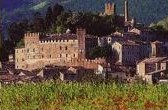 The visit starts from the original entrance, where all the drawbridge mechanisms are. Through a narrow and evocative spiral staircase you reach the top of the donjon passing by all its defensive levels. In the northern wing of the Castle there is the Museo Civico Archeologico, where remains of the roman and of the piceno populations are to be seen. The itinerary continues at the discovery of another castle, the Pallotta Castle of Caldarola that was transformed in to an elegant summer residence. The rooms were frescoed by the De Magistris brother, painters of Caldarola. Link: http://www.mondimedievali.net/castelli/Marche/macerata/provincia.htm
The visit starts from the original entrance, where all the drawbridge mechanisms are. Through a narrow and evocative spiral staircase you reach the top of the donjon passing by all its defensive levels. In the northern wing of the Castle there is the Museo Civico Archeologico, where remains of the roman and of the piceno populations are to be seen. The itinerary continues at the discovery of another castle, the Pallotta Castle of Caldarola that was transformed in to an elegant summer residence. The rooms were frescoed by the De Magistris brother, painters of Caldarola. Link: http://www.mondimedievali.net/castelli/Marche/macerata/provincia.htm
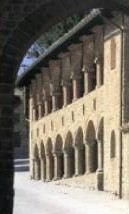 THE MEDIEVAL CITIES. Visit to San Ginesio. The village has a medieval pattern and its spectacular view of the Sibillini is a cornice to the Collegiata Romanica on the main square, a church of the XIth century with a cript frescoed by the Salimbeni brothers in 1406.You can visit the Museo Civico Scipione Gentili, with paintings ranging from the XVth to the XVIIIth century. Visit to Sarnano: In the higher square there are the church of Santa Maria Assunta (XIIIth century), the Palazzo del Podestà, il Palazzo del Popolo, now a theatre, and the Palazzo dei Priori. Walking down you can find the San Francesco church and the contiguous Pinacoteca, in wich are kept interesting paintings like the Madonna con Bambino by Vittore Crivelli. Also of interest are: The Museum of ancient and modern weapons, the Museum of avifauna and flora of the Apennines , the Museo del Martello and the permanent exhibition of the local painter Mariano Gavasci. Link: http://www.marche-turismo.it/borghi.htm
THE MEDIEVAL CITIES. Visit to San Ginesio. The village has a medieval pattern and its spectacular view of the Sibillini is a cornice to the Collegiata Romanica on the main square, a church of the XIth century with a cript frescoed by the Salimbeni brothers in 1406.You can visit the Museo Civico Scipione Gentili, with paintings ranging from the XVth to the XVIIIth century. Visit to Sarnano: In the higher square there are the church of Santa Maria Assunta (XIIIth century), the Palazzo del Podestà, il Palazzo del Popolo, now a theatre, and the Palazzo dei Priori. Walking down you can find the San Francesco church and the contiguous Pinacoteca, in wich are kept interesting paintings like the Madonna con Bambino by Vittore Crivelli. Also of interest are: The Museum of ancient and modern weapons, the Museum of avifauna and flora of the Apennines , the Museo del Martello and the permanent exhibition of the local painter Mariano Gavasci. Link: http://www.marche-turismo.it/borghi.htm
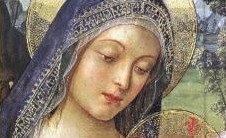 THE PICTORIAL SCHOOLS. Visit to the town of Camerino. In the city profile you can still recognize what was the capital town of the Da Varano Dukedom. Here the painters Giovanni Boccati and Girolamo di Giovanni where born, the most renown representatives of the Camerino school of painters that in the XVth century was an important stage for figurative art in central Italy. To be seen are the Duomo, the Palazzo Ducale and the Pinacoteca now in the ex monastery of San Domenico. From the glacis of the imposing Rocca built by Cesare Borgia, a magnificent view of the Sibillini chain is to be admired. Visit to the town of Matelica. Renowned for its Verdicchio di Matelica wine. On the main square, named after Enrico Mattei, there are the Palazzo Pretorio, the elegant Loggia degli Ottoni, The Palazzo Comunale and the Palazzo Ottoni with the Museo Archeologico, with a rich collection of Piceni findings. Further on the Piersanti Museum with art manufacts and paintingsof the Marchigiano school dating up to the XVth and XVIIth centuries. The visit continues at the beautiful Teatro Piermarini, where the ruins of roman thermal baths are to be seen just under the stage. The tour ends at the Centro Analisi Sensoriale dell’Enoteca Comunale, where it will be possible to taste the famous Verdicchio. San Severino Marche: the city dates back to the roman town of Septempeda and is divided in to two main parts: the medieval castle above the hill, built around the ancient Romanic Cathedral , and the village, founded during the XIIIth century for commercial reasons, with at its centre the Piazza del Popolo with its characteristic elliptic shape. San Severino has been the hometown of a renowned pictoric school: the frescoes by Lorenzo and Jacopo Salimbeni are still to be seen in the church of San Lorenzo in Doliolo (XIIth century) and the pinacoteca “Tacchi Venturi” that keeps also other important paintings of the XIVth and XVIth centuries. Link: http://it.wikipedia.org/wiki/Camerino
THE PICTORIAL SCHOOLS. Visit to the town of Camerino. In the city profile you can still recognize what was the capital town of the Da Varano Dukedom. Here the painters Giovanni Boccati and Girolamo di Giovanni where born, the most renown representatives of the Camerino school of painters that in the XVth century was an important stage for figurative art in central Italy. To be seen are the Duomo, the Palazzo Ducale and the Pinacoteca now in the ex monastery of San Domenico. From the glacis of the imposing Rocca built by Cesare Borgia, a magnificent view of the Sibillini chain is to be admired. Visit to the town of Matelica. Renowned for its Verdicchio di Matelica wine. On the main square, named after Enrico Mattei, there are the Palazzo Pretorio, the elegant Loggia degli Ottoni, The Palazzo Comunale and the Palazzo Ottoni with the Museo Archeologico, with a rich collection of Piceni findings. Further on the Piersanti Museum with art manufacts and paintingsof the Marchigiano school dating up to the XVth and XVIIth centuries. The visit continues at the beautiful Teatro Piermarini, where the ruins of roman thermal baths are to be seen just under the stage. The tour ends at the Centro Analisi Sensoriale dell’Enoteca Comunale, where it will be possible to taste the famous Verdicchio. San Severino Marche: the city dates back to the roman town of Septempeda and is divided in to two main parts: the medieval castle above the hill, built around the ancient Romanic Cathedral , and the village, founded during the XIIIth century for commercial reasons, with at its centre the Piazza del Popolo with its characteristic elliptic shape. San Severino has been the hometown of a renowned pictoric school: the frescoes by Lorenzo and Jacopo Salimbeni are still to be seen in the church of San Lorenzo in Doliolo (XIIth century) and the pinacoteca “Tacchi Venturi” that keeps also other important paintings of the XIVth and XVIth centuries. Link: http://it.wikipedia.org/wiki/Camerino
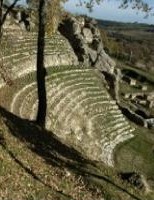 THE ROMAN PROVINCE. Visit of Urbisaglia. The archeological park of Urbs Salvia is the most important and imposing of the Marche region. The tour starts at the Museo Archeologico Statale, where a model shows the original aspect of ancient Urbs Salvia. Further on the Ancient Aqueduct Cisterns supplied the city with water. Following the Theatre, the biggest of the Marche, used for drama performances and niche building that was a scenographical connection between the various levels of the city. At the bottom of the hill there is the sacred area formed by a temple, an underground corridor decorated with scenes to be connected with the Augustan propaganda. Through the imposing city wall one reaches the Anfiteatro, very well preserved, where the gladiator’s games took place. Visit to the town of Cingoli. Maybe the most renowned view of the Sibillini and the Conero is here so much that the town is named the “balcony of the Marche”. It is still enclosed in its walls and keeps a tranquil and secluded atmosphere, with renaissance palaces and medieval churches often readapted in baroque age. In the main square there are one opposite the other the Palazzo Municipale where the Museo Archeologico Statale is housed and the cathedral. The Pinacoteca has a collection of paintings from all over the surrounding territory including a stunning Madonna by Lorenzo Lotto. The tour continues in Treia with its walls, towers and city walls, ancient houses: foreshortening of distant middle ages on a long and slender saddle of sandstone. Link: http://www.visit-marche.info/it/guide-turistiche-marche/urbisaglia/
THE ROMAN PROVINCE. Visit of Urbisaglia. The archeological park of Urbs Salvia is the most important and imposing of the Marche region. The tour starts at the Museo Archeologico Statale, where a model shows the original aspect of ancient Urbs Salvia. Further on the Ancient Aqueduct Cisterns supplied the city with water. Following the Theatre, the biggest of the Marche, used for drama performances and niche building that was a scenographical connection between the various levels of the city. At the bottom of the hill there is the sacred area formed by a temple, an underground corridor decorated with scenes to be connected with the Augustan propaganda. Through the imposing city wall one reaches the Anfiteatro, very well preserved, where the gladiator’s games took place. Visit to the town of Cingoli. Maybe the most renowned view of the Sibillini and the Conero is here so much that the town is named the “balcony of the Marche”. It is still enclosed in its walls and keeps a tranquil and secluded atmosphere, with renaissance palaces and medieval churches often readapted in baroque age. In the main square there are one opposite the other the Palazzo Municipale where the Museo Archeologico Statale is housed and the cathedral. The Pinacoteca has a collection of paintings from all over the surrounding territory including a stunning Madonna by Lorenzo Lotto. The tour continues in Treia with its walls, towers and city walls, ancient houses: foreshortening of distant middle ages on a long and slender saddle of sandstone. Link: http://www.visit-marche.info/it/guide-turistiche-marche/urbisaglia/
